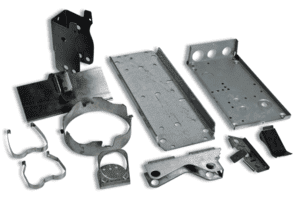At ESI, we have a deep understanding of the unique challenges our clients face in their respective industries. We're dedicated to helping them reduce costs on stamped metal parts without compromising quality. With over 30 years of experience, we’ve continuously evolved our engineering and manufacturing capabilities, leveraging advanced automated systems to deliver high-quality results.
Our expertise comes from working with automotive clients who require precision, speed, and reliability—especially when it comes to safety-critical components. This experience allows us to offer tailored solutions that meet the needs of our clients while keeping costs under control.
If you're looking to cut down on the cost of your stamped metal parts, here are three key areas you can review and optimize:
Materials
The choice of material plays a major role in the overall cost of stamping. Harder metals may be more durable, but they also require more energy and time to form, increasing production costs. By selecting a slightly softer or more malleable material that still meets your quality standards, you can significantly reduce expenses. Some materials may have similar properties but differ greatly in price, so it's worth exploring alternatives that maintain performance without breaking the bank.
Additionally, if your design originally required a specific material due to certain properties, but those requirements have since changed, you may be able to switch to a more cost-effective option. Always evaluate the current market prices and ensure the new material still meets all necessary specifications.
Tooling Requirements
Another critical factor is the tooling needed for your part. Even small changes in the design can lead to significant increases in tooling costs and production time. It’s important to minimize retooling and repairs, as these can cause costly downtime. For example, square holes typically require more complex machining than round ones, which can add to both time and cost.
Reviewing your tooling requirements can help identify ways to simplify the design without sacrificing functionality. Complex features or notches can lead to increased wear on the stamping die, potentially causing cracks or failure if not properly maintained. If such features are necessary, consider implementing a more frequent maintenance schedule to avoid unexpected breakdowns.
Production Volume
As demand for your parts increases, larger production volumes become necessary. This can open up opportunities to streamline your designs, making them easier and faster to manufacture. For prototype-based designs, now is the time to look for cost-saving modifications that maintain the part’s functionality while reducing expenses.
Material and finishing costs often decrease with higher volume purchases. Consider placing blanket orders over a set period with smaller, scheduled releases. This approach can lead to better pricing and more predictable supply chain management.
Reviewing complex features for simplification can also improve quality control and reduce the frequency of tooling maintenance. Understanding your Estimated Annual Usage (EAU) helps determine the most cost-effective tooling options, including multi-cavity molds or specialized coatings.
Adjusting the material thickness or switching to a more flexible metal can also extend die life and lower material costs. In some cases, if production volume exceeds expectations, additional tools may be required. Sharing this information upfront with your supplier ensures proper planning and avoids delays.
Quality and Cost-Effective Metal Stamping Services
By carefully reviewing your materials, tooling needs, and production volumes, you can significantly reduce the cost of your stamped metal parts. ESI has the expertise and resources to guide you through this process, ensuring you get high-quality components at a competitive price.
We work closely with our clients to develop efficient and cost-effective stamping solutions that meet industry standards. Whether you're in the early stages of design or scaling up production, we’re here to help. Contact the ESI team today and request a personalized quote to see how we can support your goals.
Hydrophilic Modifier For Amino Silicon Oil
Hydrophilic Modifier For Amino Silicon Oil Does not affect the hydrophilic properties of pure cotton and its blended fabric itself.
It can improve the hydrophilicity of chemical fiber fabrics and has antistatic properties. Suitable for all types of fibers and fabrics. Non-stick roller.
In particular, it is applied to hydrophilic soft finishing on cellulose fibers. Very low yellowing on white and light fabrics. There may be agglomerates with anions. Application experiments are required before application.
Hydrophilic Modifier For Amino Silicon Oil,Silicone Softener Amino Oil,Amino Silicon Oil,Hydrophilic Modifier For Garment
Liaoning Kelong Fine Chemical Co.Ltd. , https://www.kelongchemy.com

Comments are closed